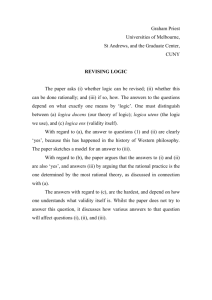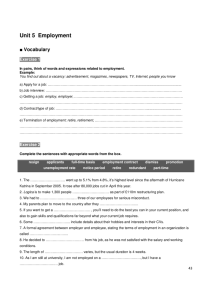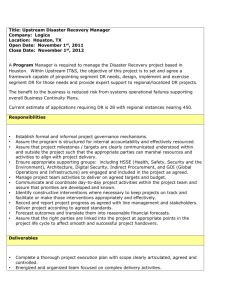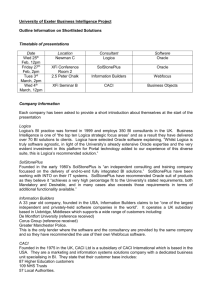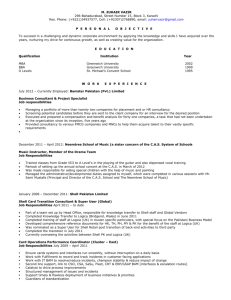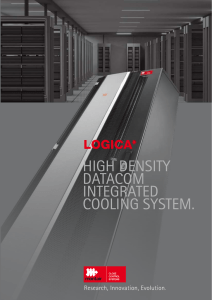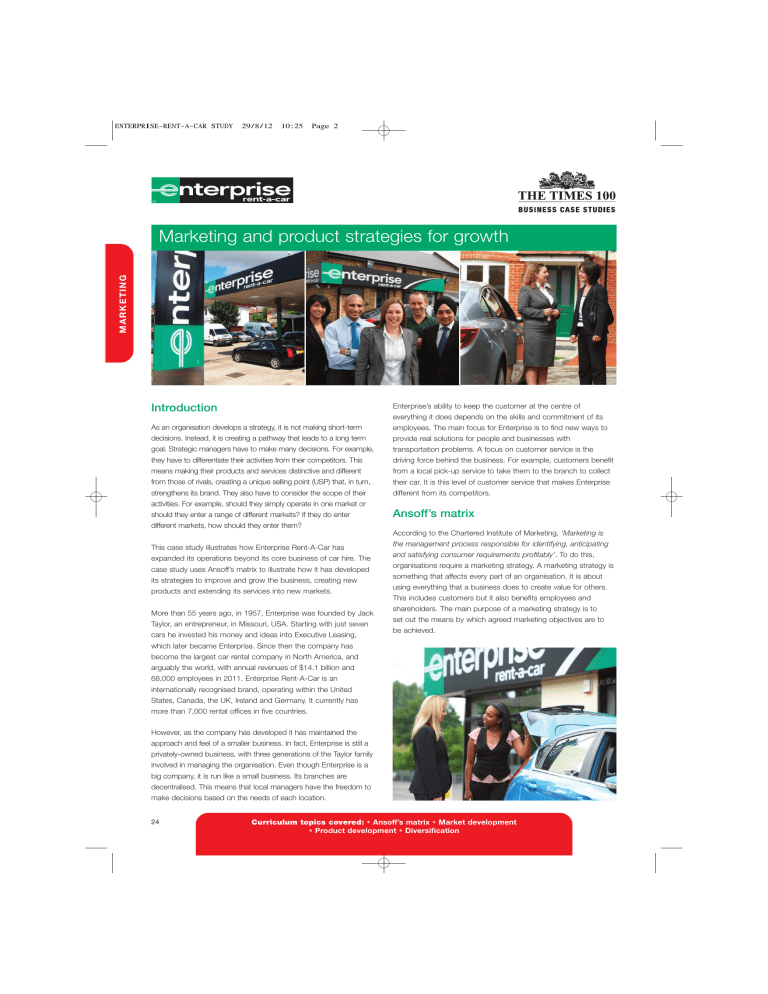
ENTERPRISE-RENT-A-CAR STUDY 29/8/12 10:25 Page 2 MARKETING Marketing and product strategies for growth Introduction Enterprise’s ability to keep the customer at the centre of As an organisation develops a strategy, it is not making short-term employees. The main focus for Enterprise is to find new ways to decisions. Instead, it is creating a pathway that leads to a long term provide real solutions for people and businesses with goal. Strategic managers have to make many decisions. For example, transportation problems. A focus on customer service is the they have to differentiate their activities from their competitors. This driving force behind the business. For example, customers benefit means making their products and services distinctive and different from a local pick-up service to take them to the branch to collect from those of rivals, creating a unique selling point (USP) that, in turn, their car. It is this level of customer service that makes Enterprise strengthens its brand. They also have to consider the scope of their different from its competitors. everything it does depends on the skills and commitment of its activities. For example, should they simply operate in one market or should they enter a range of different markets? If they do enter different markets, how should they enter them? This case study illustrates how Enterprise Rent-A-Car has expanded its operations beyond its core business of car hire. The case study uses Ansoff’s matrix to illustrate how it has developed its strategies to improve and grow the business, creating new products and extending its services into new markets. More than 55 years ago, in 1957, Enterprise was founded by Jack Taylor, an entrepreneur, in Missouri, USA. Starting with just seven cars he invested his money and ideas into Executive Leasing, Ansoff’s matrix According to the Chartered Institute of Marketing, ‘Marketing is the management process responsible for identifying, anticipating and satisfying consumer requirements profitably’. To do this, organisations require a marketing strategy. A marketing strategy is something that affects every part of an organisation. It is about using everything that a business does to create value for others. This includes customers but it also benefits employees and shareholders. The main purpose of a marketing strategy is to set out the means by which agreed marketing objectives are to be achieved. which later became Enterprise. Since then the company has become the largest car rental company in North America, and arguably the world, with annual revenues of $14.1 billion and 68,000 employees in 2011. Enterprise Rent-A-Car is an internationally recognised brand, operating within the United States, Canada, the UK, Ireland and Germany. It currently has more than 7,000 rental offices in five countries. However, as the company has developed it has maintained the approach and feel of a smaller business. In fact, Enterprise is still a privately-owned business, with three generations of the Taylor family involved in managing the organisation. Even though Enterprise is a big company, it is run like a small business. Its branches are decentralised. This means that local managers have the freedom to make decisions based on the needs of each location. 24 Curriculum topics covered: • Ansoff’s matrix • Market development • Product development • Diversification ENTERPRISE-RENT-A-CAR STUDY 2/10/12 14:06 Page 3 This matrix suggests four alternative marketing strategies: a) Market penetration - involves selling more established products into existing markets, often by increased promotion or price reductions or better routes to market, for example online. b) Product development - involves developing new products or services and placing them into existing markets. c) Market development - entails taking existing products or services and selling them in new markets. d) Diversification - involves developing new products and putting them into new markets at the same time. Diversification is considered the most risky strategy. This is because the business is expanding into areas outside its core activities and There are many types of marketing objectives. For example, these might include: • increasing market share experience as well as targeting a new audience. It also has to bear the costs of new product development. Enterprise has focused most of its growth strategies on market • growing sales/turnover development, product development and diversification. These are • enhancing the strength of the brand highlighted in the following sections. • creating loyal customers • managing costs effectively, thus increasing profitability. A common marketing objective is to achieve growth. There are a number of ways in which organisations can grow. For example, they might expand internally. This is known as organic growth. A quicker but higher risk option is external or inorganic growth. This involves acquiring or merging with another business. One positive benefit of growth is that it helps a business to reduce costs through economies of scale. These include: • efficiencies arising from use of new technologies • improved buying power as it can bulk buy at lower costs • the ability to recruit more specialists to improve decision making. By lowering costs, an organisation increases its profitability and Market development becomes more competitive. One way of analysing the various strategies that an organisation may use to grow the business is with Igor Ansoff’s (1965) matrix. This considers the opportunities of offering existing and new products within existing and/or new markets and the levels of risk associated with each. In 1957 Jack Taylor was a 35 year-old sales manager interested in the unheard-of practice of leasing cars. This was then a new and affordable alternative to running a car. Jack Taylor’s background in the US Navy made him realise the importance of taking care of those around you. His motto was, ‘Take care of your customers and employees, and the profits will follow’. Customer service and good employee relations therefore became Increasing risk Existing markets New markets Existing products New products Market penetration Product development Market development Diversification Increasing risk Product Market the cornerstone of the business. It was this that helped the business to grow. From 1957 – 1993 Enterprise concentrated on expanding its operations across the USA. In this time it opened over 1,000 rental branches. Throughout the 90s Enterprise developed into markets in Canada, the UK, Germany and Ireland. www.thetimes100.co.uk 25 ENTERPRISE-RENT-A-CAR STUDY 29/8/12 10:25 Page 4 world are committed to reducing global warming through more ecofriendly technologies, while consumers are looking for different mobility solutions. Enterprise therefore created WeCar, a membership carsharing programme which offers customers a car at an affordable hourly rate. It typically uses fuel-efficient vehicles or hybrids to help address concerns about the environment. Car sharing or hourly car rental can also help to reduce the number of cars on the road. In this way, WeCar members help to contribute to a cleaner environment. Having the ability to respond quickly to the external environment with new products and services is a benefit of being a privatelyowned business. Enterprise allows employees to make decisions at a local level and has created an entrepreneurial spirit within the organisation. This means that strategies are constantly reviewed to ensure that Enterprise remains the market leader. New avenues of In the car rental business, as all organisations are providing a business are explored and researched. Underlying all of these similar product, a key factor that differentiates one organisation changes are Enterprise’s founding values. These are Enterprise’s from another is the quality of the service that is provided for driving forces behind growth and include values such as: customers. Enterprise’s dramatic growth strategy has been made • ‘Our brand is the most valuable thing we own. possible through its high level of customer service. By listening to • Great things happen when we listen...to our customers and to its customers, it is able to provide greater satisfaction, with employees being a vital part of that process. each other. • Customer service is our way of life.’ To provide superior customer service, Enterprise locates its branches as close as possible to its customers. The convenience of this service gives Enterprise a competitive advantage over its rivals. However, in response to customer needs, Enterprise opened its first on-airport location in 1995. The demand for this service was so great that by 2005 Enterprise had over 200 on-airport branches. This meant that Enterprise kept ahead of its competitors and increased its market share. Product development Product development strategies have helped Enterprise to develop services in a market where it was already an established and profitable business. This was considered to be a medium risk strategy. Examples of Enterprise’s product development include its unique ‘Pick-up’ service. This helped to lead the market in this product offering. Enterprise’s Flex-E-Rent service (a long term vehicle rental solution designed to meet the growing needs of today’s businesses) and its Business Rental Programme (offering customers a bespoke programme with special pricing) are examples of product developments. These have widened its service range to improve the customer experience and strengthened its brand identity. Factors in the external environment affect decisions about product development. These are things taking place outside the business that influence decisions within the organisation. Governments around the 26 www.thetimes100.co.uk ENTERPRISE-RENT-A-CAR STUDY 29/8/12 10:25 Page 5 www.enterprise.co.uk As a result, Enterprise’s activities are polycentric. This means that and expensive, many customers swapped large cars for some services are only offered in certain markets. For example, smaller and more economical vehicles. This led to a collapse of Rent-A-Car is operated in all markets globally. WeCar is operated sales in the used car market. Enterprise relied on that market to in the UK and the USA and Flex-E-Rent is only available in the UK. sell on its vehicles. The future of the business was not certain Diversification Diversification strategies involve widening an organisation’s scope across different products and market sectors. It is associated with higher risks as it requires an organisation to take on new experience and knowledge outside its existing markets and products. The organisation may come across issues that it has never faced before. It may need additional investment or skills. and so Enterprise diversified to buy Keefe. It was hoped that acquiring small, underdeveloped businesses would generate more opportunities for Enterprise. c) In 1977 Enterprise invested in Mexican Inn Chili Products. However, the company had little experience of both the packaged goods industry and the packaged food business. Poor sales and a guaranteed buy-back arrangement with retailers (where unsold goods could be returned) meant that the business did not make a profit. Therefore the company sold the business but learned a lot from the experience. This last example illustrates the risk that diversification poses. Just because a business is successful, like Enterprise, it can never guarantee success in every venture it undertakes. However, the experience with Mexican Inn did not put Enterprise off later acquisitions that were outside the car rental business, for example, TRG Group which is a leading manufacturer of luggage, backpacks and travel accessories. Conclusion A marketing strategy is something that constantly evolves, adapting to changing market conditions. Within Enterprise, the outcomes from its many different types of business are constantly reviewed and evaluated. Judgements are then fed into the decision-making process. This enables new strategies to be On the other hand, however, it provides the opportunity to explore developed to improve operations. new avenues of business. This can spread the risk allowing the organisation to move into new and potentially profitable areas However, while strategies change, one aspect of the business has of operation. remained in place. This is a continued focus on high levels of customer service and employee relations. This strategy has Enterprise’s values help to define what the organisation stands for. enabled Enterprise to enjoy continued growth for more than They also identify its capability and competences. Its core values 55 years and the prospect of further growth in the future. of ‘brand, honesty, service, fun, hard work, listening, inclusion and community’ are transferable. This means that the skills from the 1. What is a marketing strategy? (2 marks) through diversification, potentially reducing the risks associated 2. Explain how the diversification strategy within the with this strategy. Examples of Enterprise’s diversification Ansoff matrix differs from the other three strategies. strategies include: (4 marks) 3. Show with examples how research into product a) Car Sales was established by Enterprise in 1962. This business involves selling used cars to both the public and businesses. It is now one of the largest sellers of used cars in the USA. b) In 1974 Enterprise purchased Keefe Coffee Company, which later developed as the Centric Group. The 1973 energy crisis development at a local level helps organisations to respond to the needs of its local environment. (6 marks) 4. Evaluate why some diversification decisions might be Exam-style questions main business can be applied to other business opportunities higher risk than others. (8 marks) had created uncertainty for Enterprise. As fuel became scarce Enterprise Rent-A-Car | Marketing and product strategies for growth 27 JD SPORTS STUDY 29/8/12 10:28 Page 2 MARKETING Using market research to support decision making Introduction The group has also secured brands such as The Duffer of Organisations that operate in the business-to-consumer (B2C) brands Chilli Pepper, Nanny State and Sonneti. The JD Sports market are increasingly turning to market research to support their Fashion Group now has over 900 stores across the UK and decision making processes. A retail business, for example, might Europe and a reputation for stocking exclusive and stylish ranges. St George, Sergio Tacchini (under UK licence) and the fashion be considering opening new stores, expanding internationally, proposing to diversify its product range or thinking about acquiring another company. Before proceeding, the business will require specific information to understand the implications of making such changes. The process of collecting this information and developing this understanding is known as market research. This case study focuses on how JD (part of JD Sports Fashion PLC), the UK’s leading retailer of fashionable sports and leisure wear, uses market research to support and develop its business. As a B2C retailer, JD’s performance depends on providing the most desirable brands and products at the right price and in the right locations to meet with the demands of the consumer. Founded in 1981 in Mossley, near Manchester, JD today is a What is market research? The exchange between sellers (supply) and buyers (demand) for particular goods or services is called a market. A market does not necessarily exist in a single location, nor need it be a real location – products can be bought and sold online. Markets change constantly and businesses need to have a clear understanding of both the supply and demand. The principal role of market research, therefore, is to provide a business with a comprehensive view of consumers in order to develop products and services that satisfy their needs better than the competition. Also, given the increased complexity of the business environment, it is no longer enough to make key decisions using a ‘gut-feel’ nationally recognised UK high street fascia. For 20 years, the approach alone. Decisions need to be informed and market business expanded through organic growth, meaning that growth research helps to support this process, significantly reducing the was generated by building sales revenue through increasing its level of financial risk attached with investment decisions. network of stores. JD has expanded more rapidly in recent years through acquisitions (inorganic growth), significantly increasing its JD store base through the purchase of First Sport (2002) and All:sports (2005). Through the purchase of Scotts (2004), Bank (2007) and, most recently, Blacks (2012), it has diversified the business into the young branded fashion and outdoor markets. The Group has also made international acquisitions including Chausport (France), Champion Sports (Ireland) and Sprinter (Spain) as it has expanded its business overseas. 40 Curriculum topics covered: • What is market research? • Primary market research • Secondary market research • Quantitative and qualitative market research JD SPORTS STUDY 29/8/12 10:28 Page 3 Market research involves the capture and analysis of consumer, These are: competitor and market trend data. This enables JD to assess • market penetration – winning greater market share in its more accurately the level of demand for its products. It also influences decisions to target capital investment on projects that will offer the best return on that investment, such as opening a existing markets • market development – entering new countries or new retail sectors new store or entering a new market. • product development – acquiring or developing new products Market research provides consumer feedback. It is essential for JD • diversification – taking the business in a completely new or brands to have this dialogue with the consumer to gain insight into what direction. they think about its range of products, brands and services. This enables the business to meet its demands and outperform the Product competition. It helps the business develop a clear and informed strategic business plan which all business colleagues can work Market Present New towards fulfilling. For example, this information can create a winning marketing mix to target promotions to reach different customer Present Market penetration Product development New Market development Diversification groups or influence decisions on range planning in new stores. Market research informs the marketing mix Primary market research Product decisions Focused on consumer expectations Prices Create value for customers Place Stores in locations convenient for customers Promotion Reach customers through targeted messages There are principally two types of market research – primary and secondary. Primary research is sometimes known as field research. This is because it involves gathering data through new Research can also provide information about the size and research. This data can be collected in either a quantitative or performance of markets. It can inform a business about who the qualitative format. key competitors are, what they are doing, and their market share. Potential areas of opportunity within an international, national and Quantitative research is numerically-based and obtains the hard local context can also be identified. By using tools such as an numbers from which decisions can be made with confidence. Ansoff’s matrix to assess the levels of risk, JD can then decide which marketing strategies to focus on. Examples of quantitative market research at JD include: • Exit surveys – carried out face-to-face with consumers as they leave the store. This is a simple survey covering a cross-section of stores to gather the views of consumers in different locations and regions. At JD the purpose of the survey is primarily to understand the reasons for visit, frequency of visit/purchase and reasons for and against purchase. • The ‘shopping bag’ survey – the JD research team monitors what carrier bags customers entering JD stores are carrying. This helps identify what other stores JD customers use and are spending money in. It provides competitor insight and an idea of which retailers attract a similar customer profile to JD, a variable that can influence the location of new JD store openings. • On-site fieldwork – JD’s dedicated Site Research team invests significant time researching new locations. This involves defining the extent of a location’s catchment area, reviewing the presence and quality of the competition and assessing the pitch and visibility (i.e. how busy the area is) of a unit. This helps build a detailed SWOT analysis of each new site. www.thetimes100.co.uk 41 JD SPORTS STUDY 2/10/12 14:09 Page 4 • Commercial market research reports – prepared by research experts, these provide estimates of the size (volume of sales) in each product or market category and market share by operators within these sectors. At JD this information is invaluable when assessing new product markets (e.g. outdoors) or international opportunities (e.g. France and Spain). However, there are drawbacks with any form of market research. It costs money to collect and analyse large amounts of information and the results are not always definitive. Numerical data might be biased, particularly if the sample size is too small. Focus groups may be skewed if one member of a focus group is too dominant and stops others from voicing their opinions. Qualitative information is a primary form of market research which focuses on consumer feelings and opinions on a product or Market research at JD service. This type of research illuminates the facts and figures The location of stores is a critical element of the success of a collected through quantitative research. Examples of qualitative retailer in any market. Sound competitive locations can provide a research at JD include: source of competitive advantage. To achieve this it is essential to • Focus groups – by speaking at length with small groups of build a clear understanding of the consumer and how they interact 8-10 people, more insightful questions can be asked regarding with a retailer and its sales channels (i.e. stores, internet or kiosks). brands and new product developments. At JD these are typically run in schools and colleges, where it can get direct So, how does JD build up information about its consumers and feedback from its core consumers. develop a clear location strategy? One method employed by the • Depth interviews – this involves a researcher accompanying the company is its check-out survey. This is a simple but highly consumer on a shopping trip in store. This drills deeper into effective survey that is carried out with customers at the till. By shopper behaviour and their reactions to stores. collecting the customer’s home postcode, gender and age and matching this data to the products purchased, JD can build up When undertaking market research, it is important to reflect the detailed consumer profiles. views of all consumers within the business’ target market. However, this would be a huge exercise. One way of managing this is to use sampling methods. Sampling involves taking the responses of a representative group of consumers that are likely to reflect the opinions of the customer base. Secondary market research Secondary research is sometimes known as ‘desk research’. This research draws on material that has been collected by another organisation to provide market information. Secondary research data provides a fact-based overview of the market. Examples of secondary research include: • Government census data – the census is conducted every 10 years across the UK and brings together data on factors such as the number of people, their ages and occupations in a location. • Geo-demographic data – collected by specialist agencies, this segmentation tool profiles consumers based on their lifestage (e.g. marital status, number of children) and their lifestyle (e.g. newspapers read, leisure activities, TV programmes watched). 42 www.thetimes100.co.uk JD SPORTS STUDY 29/8/12 10:28 Page 5 www.jdsports.co.uk JD also asks purchasers a further question: has the item been It is important that research is properly managed to ensure that the purchased for yourself or for another person? This helps JD to data collected is valid and reliable. It is also useful, where practical, to understand the difference between customers (the purchaser) and use a variety of methods to validate research findings. At JD the its consumers (the end user). For example, some purchases are findings from the exit surveys (smaller sample sizes) are validated by made by parents buying clothes or shoes for their children. This the check-out survey (larger sample size). additional question helps prevent the survey results from being misinterpreted. The survey is carried out annually over a two-week period and involves over 350,000 customers. This provides a robust sample from which to extract invaluable insights into consumer buying behaviour. In-depth analysis of the survey results helps the company: • understand how far customers travel to stores – this enables Put together, this information helps JD to anticipate the level of demand customers may have for its products. Sales expectations can be accurately forecast to ensure profitable stores are opened. JD has also embraced the internet as a means to support business strategies. The data collected through the online ordering process is JD to define real catchment areas for each store and ‘live’ information and it provides a valuable insight into consumer understand the overlap with other existing stores demand. It can influence store ranges and support decisions about • build consumer profiles by gender, age, brand and lifestyle its stores network by highlighting ‘hotspots’ with high levels of • identify and quantify new store location opportunities demand but no physical presence. In an increasingly multi-channel • influence product ranges to meet the buying habits of world, capturing, analysing and acting on this information offers a customers in different locations • assist with marketing strategies to target the consumer business a key competitive advantage. Again, this information can provide useful insight into potential international opportunities. more effectively. This type of information is collected regularly by large retailers such Conclusion as supermarkets through the data collected on their store loyalty In recent years, the UK retail industry has faced challenging cards. However, loyalty card schemes can be very expensive to run. conditions. However, against this tough economic backdrop, Till surveys, although only providing a snapshot of the consumer, JD has managed to maintain growth through a thorough offer a cost effective means of gathering data. JD is relatively unique understanding of market opportunities. Market research is not a on the high street in using this type of survey to capture additional one-off process. Markets change and a business like JD needs to customer information. More recently this survey has been replicated evaluate customer trends and monitor competitors on a regular across JD stores in France and Spain. basis in order to remain competitive. JD has therefore established research mechanisms to provide ongoing feedback. These provide a mix of qualitative and quantitative market data obtained directly from consumers and from published research. By understanding its consumer base, JD has established itself as the market leading retailer of fashionable sports and leisure wear. 1. Describe the difference between primary and purpose of market research. (4 marks) 3. Analyse why market research should be viewed as an ongoing process. (6 marks) 4. Evaluate how market research, if undertaken properly, adds value to the decisions made by a large company. Exam-style questions secondary market research. (2 marks) 2. Use an example from the case study to explain the Why does it help to reduce risk? (8 marks) JD Sports | Using market research to support decision making 43 LOGICA 29/8/12 10:30 Page 2 ENVIRONMENT Using skills to respond to the external environment Introduction For example, Logica has provided: Businesses do not operate in isolation. They are constantly faced • the outsourcing of IT and technical applications for Taylor • the automated ticketing system for London Underground with internal and external factors that impact on the dynamics of their operations. Monitoring the external environment is vital to identify changes that could affect the business operations. Being able to address and adapt to these changes ensures the longer term survival of the business. Wimpey, the UK house building business • business applications for the Ministry of Justice’s Courts, Tribunals and offices • the design of electronic security services for the UK’s Department of Defence • the system for generating Premium Bonds (ERNIE). Logica is an innovative IT services organisation that brings people, business and technologies together. Logica employs more than Logica therefore requires highly skilled employees who are able to 41,000 people and has clients around the world in a variety of adapt and deal with a range of challenges. The work of Logica is not industries including automotive, oil and gas and manufacturing. just about developing technology. It is about getting business benefits Logica’s services aim to add value for clients through, for example, from the technology available. It is also about enabling clients to improving efficiency and productivity or reducing waste. reduce environmental impacts. Logica’s experts increasingly provide sustainable and long-term solutions for its customers. For example, it works with governments and automotive companies to develop and promote sustainable methods of transport. Political influences This case study illustrates how Logica monitors its external environment using PEST analysis. This is a structured business tool that looks at the political, economic, social and technological Technological influences Business influences affecting a business. By auditing and monitoring these influences, Logica can be proactive in ensuring it remains competitive by adapting its own business and by generating innovative and unique solutions for its clients. For businesses to stay ahead of their competitors, they have to Social influences deliver innovative products and services. Logica works with customers to aid business development. 52 Curriculum topics covered: • Political factors • Economic factors • Social factors • Technological factors Economic influences LOGICA 29/8/12 10:30 Page 3 Also, in 2007 Logica launched a three-year sponsored degree programme with the University of Winchester. The degree programmes BA (Hons) Business Management and BA (Hons) Business Management with IT attract applications from students throughout the UK. These degrees allow students to combine academic study with on-the-job learning. Students spend one day a week studying on campus and four days a week working at Logica. Logica pays the course fees as well as offering students an attractive salary from day one. Upon graduation they can further develop their professional career within Logica. As part of its sustainable focus, Logica has also responded quickly to government initiatives on climate change and reducing emissions. For example, it has been involved in the government’s new Cycle Hire Scheme in London. It secured the contract for the Political factors Business decisions may be influenced by political factors. For example, recent public sector budget cuts by the UK government and increased university fees are affecting the education sector. For students this has meant making key decisions about how they major IT components with Serco, the contractor responsible for designing, building and operating the system. Logica’s role is central and focuses on the design and build of the simple-to-use payment system. This is supported by a back office function. Economic factors intend to pursue their careers. This in turn has meant that Economic factors change rapidly and are sometimes difficult to academic providers need to review how they will meet the predict. The global economic recession has affected how most challenges of generating income. firms conduct business, perhaps by looking for cost-savings or reducing waste. As businesses focus on areas where efficiencies Logica identified that these changes in the educational landscape can be made, some might choose to outsource functions to could have an impact on the number of potential employees with reduce costs, rather than employing people with specialist skills. the skills and competencies that it requires. For example, it had to This has created increased demand for outsourced services such consider the affordability of higher education for students and how as those Logica offers. Logica’s employees have the specialist IT this could influence long-term development opportunities within skills required to offer businesses of all types efficient and effective the company. The increasing cost of becoming a student may ways to manage systems and processes. restrict the social mobility of talented individuals and they may then need to consider alternative routes to gaining qualifications and experience. Logica has therefore reviewed its workforce planning. It has now engaged in strategies to ensure it has enough workers with the right skills both now and in the future. To address the changes in the educational landscape, Logica has introduced apprenticeships and enhanced its graduate scheme. Logica has embraced the strategy of direct training as it provides the company with a new pool of talent, with the focus on individuals who have decided to specialise in IT or Computer Science. This is why Logica has embarked on creating Level 3 Apprenticeships in 2012. This widens the range of talented young people that Logica needs and supports the organisation’s long-term commitment to career development of its employees. www.thetimes100.co.uk 53 LOGICA 29/8/12 10:30 Page 4 The make-up of society is also changing. The UK has an older and more diverse society with people from many different backgrounds and cultures. A diverse workforce brings together people with different skills and competencies. Diversity is therefore a focus of Logica’s HR strategy. Logica competes with many other firms for a limited pool of highly talented individuals with good IT and numerical skills. To increase this pool of talent, Logica aims to increase the number of females in its workforce. Within the IT industry, females only account for an average of 16% of the graduates in Computer Science/IT. Logica understands that increasing the number of females in its workforce will bring different strengths. Logica has been heavily Logica was selected by BAE Systems, the global defence and involved in driving equality within the workplace. It has supported security company, to provide a Human Resources outsourcing the Women’s Empowerment Principles (WEPs). This is a service for its employees within the UK. Logica works with BAE partnership initiative of the United Nations. It has joined 267 to increase the effectiveness of its systems and to enhance the nations across the world in order to improve gender equality. This efficiency of its operations. This improves how BAE engages with has helped to empower women within the workplace and the its employees to maximise their potential. This also helps BAE community. To do this they have created a Women’s Mentoring to reduce its costs and focus on growth. Programme aimed at supporting women in their career development. This will ensure that more women rise through the The recession in the UK has also heightened the need for the ranks into positions of senior management. government to cut spending. One example of this is the government’s commitment to achieving savings through the better Another way that Logica is addressing this issue is by supporting use of its technologies. As a result Logica has been awarded a IT clubs in local schools near Logica’s offices across the UK. 10-year outsourcing contract with the Serious Organised Crime These clubs promote the importance of IT and demonstrate the Agency. During this contract Logica will manage the Agency’s variety of exciting career opportunities available within the industry, information and communication technologies and related services. particularly for young women. This creates efficiencies by bringing together data centres and networks, whilst helping the Agency to exploit intelligence and By offering a range of different routes into the business and case management more effectively through an integrated system. making education more affordable, Logica is able to provide an exciting and desirable option for career development. Similarly, Logica’s services have helped Transport Scotland to put together the largest ticketing scheme in the world. This has involved the installation of new electronic ticket machines on 7,000 buses and 200 bus operator sites. The system processes over 12 million journeys every month and delivers cost-savings in terms of employee time. Social factors Social factors reflect the constant change in society’s interests, beliefs and actions. There are now different working patterns available which allow men and women to balance work and life commitments better. New technology is driving faster and more integrated forms of communication - 25 years ago the mobile phone was just an evolving concept; the personal computer and internet were just starting to make an impact. 54 www.thetimes100.co.uk LOGICA 29/8/12 10:30 Page 5 www.logica.co.uk Logica’s technology supports its clients in many ways but to do this it needs to be able to offer a dynamic and innovative working environment for its highly skilled employees from diverse backgrounds. Logica’s people are key to the technologies that it provides, as employees need to have both the IT skills and an innovative mindset. As an example, graduates within the business may be involved in any part of the organisation, from business consultancy, systems design and development and implementation, to testing the support of new technologies, training or applications management. Conclusion Technological factors The external environment in which businesses operate changes The speed of technological advances means that existing electronic all put pressure on organisations. Logica is a global business that equipment, IT processes and systems will quickly become dated. To provides innovative solutions in data and systems management for remain competitive a business must ensure that its processes and its clients, helping their organisations to respond to external systems support innovation and creativity for itself and its factors. The nature of the work that Logica can offer an employee customers. Logica has embraced recent advances in technology to is both challenging and stimulating. very quickly. Political, economic, social and technological changes offer its clients the most advanced and sustainable services possible. An example of this is the use of ‘cloud’ technology. Cloud By monitoring and auditing its own external environment, Logica technology allows companies to access and buy into data storage has also been able to adapt its business to maximise efficiency or software ‘on demand’ through the internet. It enables companies and exploit opportunities. This has been done through adjusting to access a shared infrastructure. This eliminates the need for firms its service offering to utilise advancements in technology and drive to buy software for every staff member or support a server to store improvements to IT services for clients. company data and pay for staff to maintain it. This in turn reduces waste in terms of both time and money and can help a business to become more competitive by unlocking capital. This capital can then be invested in other areas. Logica has also worked with the UK police force to develop the Police National Database. This is the most secure national police system developed to date and only authorised and vetted users will have access to the system. It will make a big difference to policing in the UK as all police forces will now have easy access to key information from forces around the country. The system will make a real difference in protecting people in society. Technology can also help businesses to meet the issues of are keen to reduce waste and be more energy-efficient. Using more efficient IT systems can help reduce waste, recycle more or cut carbon emissions. For example Logica has created innovative software for Ford which monitors vehicle emissions. If drivers behave in an environmentally efficient way, they may benefit from fuel discounts. Systems like this help businesses save money through reduced fuel consumption whilst also reducing emissions. Logica | Using skills to respond to the external environment and social influences that have affected the educational landscape. It now offers a variety of entry routes into the business, such as apprenticeships, sponsored degrees and graduate programmes. The business has created long-term career development opportunities for young people. Logica is also actively addressing the shortage of females within IT. 28% of its recent intake of graduates were female. This is a significant improvement on the industry average of just 16%. Logica hopes to increase this further through its IT clubs in schools, which further promote the exciting and varied career opportunities available within the industry. 1. Describe the four elements of a PEST analysis. (2 marks) 2. Give four examples of other external factors not featured in the case study. (4 marks) 3. Analyse how social influences have changed the attitudes and approaches of employers towards employees. (6 marks) 4. Evaluate how the external environment influences the decisions that businesses make. (8 marks) Exam-style questions sustainability. Sustainability is now a high priority and businesses In addition, Logica has been proactive in dealing with the political 55
